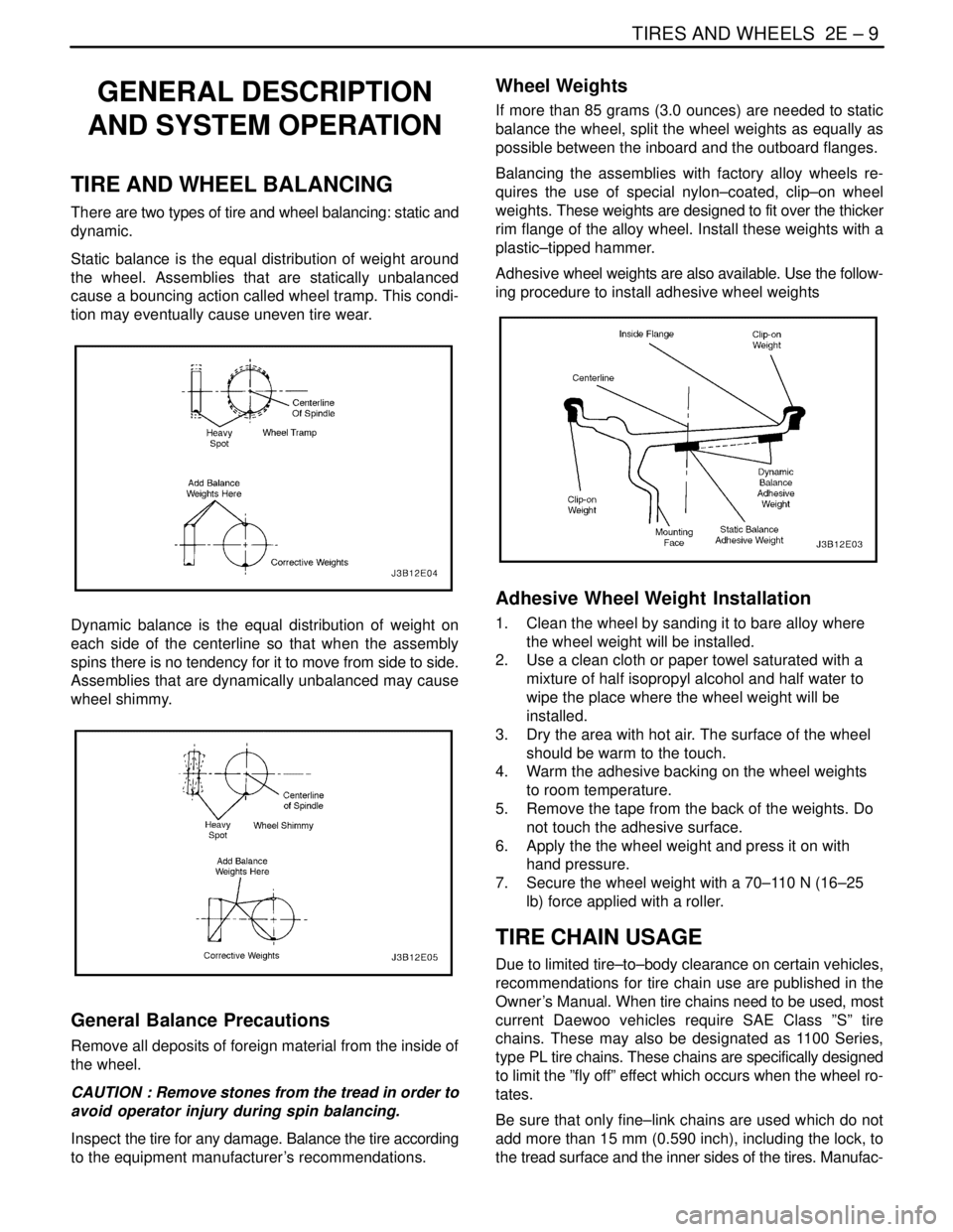2004 DAEWOO LACETTI tow
[x] Cancel search: towPage 717 of 2643

ENGINE CONTROLS 1F – 471
DAEWOO V–121 BL4
The EGR Decel Filter value should always be at –3 or low-
er. If the EGR Decel Filter number becomes more positive
(towards 0 or more), then the EGR system is becoming re-
stricted. Look for possible damage to the EGR pipe or for
a restriction caused by carbon deposits in the EGR pas-
sages or on the EGR valve.
Test Description
Number(s) below refer to the step number(s) on the Diag-
nostic Table.
1. The On–Board Diagnostic (EOBD) System Check
prompts the technician to complete some basic
checks and store the freeze frame and failure re-
cords data on the scan tool if applicable. This
creates an electronic copy of the data taken when
the malfunction occurred. The information is then
stored on the scan tool for later reference.
2. Commanding the EGR valve open determines
whether the EGR system can control the EGR
valve accurately and if the fault is present. The dif-
ference between the current and commanded posi-
tion is greater than 15%.
3. When the EGR valve electrical connector is discon-
nected, the scan tool should display the Actual
EGR Position as 0%. If it does not, the fault lies
either in the EGR signal circuit or the ECM.
4. There may be a slight delay for the voltage dis-
played on the DVM to change after the scan tool
commands the EGR valve to operate.
5. An open or poor connection condition may have
caused this DTC to set. Be sure to check the termi-
nals for being backed out, improperly formed or
damaged, and for poor tension.
7. The test light will have glowed brightly in the pre-
vious step if the EGR control circuit was shorted to
B+ and the Actual EGR Position on the scan toolwill display 100%. A test light that did not illuminate,
indicates that the circuit may be open or shorted to
ground.
9. If the EGR valve 5 volt reference is shorted to volt-
age, the digital voltmeter (DVM) will read battery
voltage and additional DTCs may be set and the
engine performance will be poor.
12. The replacement ECM must be reprogrammed.
Refer to the latest Techline procedure for ECM re-
programming.
13. Although the circuitry acted correctly when
checked, a problem may still lie within the terminals
which would not show up in probe type testing. Be
sure to check the terminals for being backed out,
improperly formed or damaged, and for poor ten-
sion.
17. All circuits to the EGR valve are OK at this point.
The fault lies internally in the EGR valve and, there-
fore, must be replaced. Be sure all gasket material
is removed from the EGR mounting surface. Even
a small amount of material may cause a DTC
P0401 to set.
18. Check the terminals for being backed out, improp-
erly formed or damaged, and for poor tension.
19. Clearing DTCs is a very important step for this
diagnostic. The clearing function allows the EGR
valve to relearn a new pintle position as the old
pintle position was inaccurate due to the failure that
caused the DTC. The DTC must be cleared with
the ignition ON, engine OFF or when the engine is
idling. If the ECM sees a EGR command, the new
pintle will not be learned.
20. If no malfunctions have been found at this point and
no additional DTCs were set, refer to ”Diagnostic
Aids” in this section for additional checks and infor-
mation.
DTC P0402 – Exhaust Gas Recirculation Excessive Flow
StepActionValue(s)YesNo
1Perform an On–Board Diagnostic (EOBD) System
Check.
Was the check performed?–Go to Step 2Go to
”On–Board
Diagnostic Sys-
tem Check”
21. Install a scan tool to the Data link Connector
(DLC).
2. Turn the ignition ON.
3. Command the Exhaust Gas Recirculation
(EGR) valve to the specific values.
Does the Actual EGR Position follow the Desired
EGR Position?25%, 50%,
75%, 100%Go to Step 19Go to Step 3
31. Turn the ignition OFF.
2. Disconnect the EGR valve.
3. Turn the ignition ON.
4. With a test light connected to B+, probe the
EGR valve wiring harness connector terminal
2.
Does the test light illuminate?–Go to Step 4Go to Step 5
Page 747 of 2643

ENGINE CONTROLS 1F – 501
DAEWOO V–121 BL4
DIAGNOSTIC TROUBLE CODE (DTC) P0506
IDLE SPEED RPM LOWER THAN DESIRED IDLE SPEED
Circuit Description
The Engine Control Module (ECM) controls the air enter-
ing into the engine with an Idle Air Control (IAC) Valve. To
increase the idle rpm, the ECM commands the pintle in-
side the IAC valve away from the throttle body seat. This
allows more air to bypass through the throttle blade. To de-
crease the rpm the ECM commands the pintle towards the
throttle body seat. This reduces the amount of air bypass-
ing the throttle blade. A scan tool will read the IAC valve
pintle position in counts. The higher the counts, the more
air that is allowed to bypass the throttle blade. This Diag-
nostic Trouble Code (DTC) determines if a low idle condi-
tion exists as defined as 100 rpm below the desired idle
rpm.
Conditions for Setting the DTC
S No intrusive tests are active.
S DTC(s) P0106, P0107, P0108, P0112, P0113,
P0117, P0118, P0122, P0123, P0131, P0132,
P0133, P0135, P0141, P1133, P1134, P0171,
P01167, P1171, P0172, P0201, P0202, P0203,
P0204, P0300, P0336, P0337, P0341, P0342,
P0351, P0352, P0402, P0404, P1404, P0405,
P0406, P0443, and P0502 are not set.
S Engine is running more than 60 seconds.
S Barometric Pressure (BARO) is greater than 72
kPa (10.4 psi).
S Engine Coolant Temperature (ECT) is greater than
60°C (140°F).
S Ignition voltage is between 11 and 16 volts.
S Manifold Absolute Pressure is less than 60 kPa (8.7
psi).
S IAC valve is controlled fully opened.
S All of the above must be met for greater than 5 sec-
onds.Action Taken When the DTC Sets
S The Malfunction Indicator Lamp (MIL) will illuminate
after three consecutive ignition cycle with a fail.
S The ECM will record operating conditions at the
time the diagnostic fails. This information will be
stored in the Freeze Frame and Failure Records
buffers.
S A history DTC is stored.
Conditions for Clearing the MIL/DTC
S The MIL will turn off after four consecutive ignition
cycles in which the diagnostic runs without a fault.
S A history DTC will clear after 40 consecutive warm–
up cycles without a fault.
S DTC(s) can be cleared by using the scan tool.
S Disconnecting the ECM battery feed for more than
10 seconds.
Diagnostic Aids
Inspect the IAC valve electrical connection for proper mat-
ing.
Inspect the wiring harness for damage.
Inspect the throttle stop screw for signs of tampering.
Inspect the throttle linkage for signs of binding or exces-
sive wear.
A slow or unstable idle may be caused by one of the follow-
ing conditions:
S Fuel system too rich or too lean.
S Foreign material in the throttle body bore or in the
air induction system.
S A leaking or restricted intake manifold.
S Excessive engine overloading. Check for seized
pulleys, pumps, or motors on the accessory drive.
S Overweight engine oil.
Page 750 of 2643

1F – 504IENGINE CONTROLS
DAEWOO V–121 BL4
DIAGNOSTIC TROUBLE CODE (DTC) P0507
IDLE SPEED RPM HIGHER THAN DESIRED IDLE SPEED
Circuit Description
The Engine Control Module (ECM) controls the air enter-
ing into the engine with an Idle Air Control (IAC) Valve. To
increase the idle rpm, the ECM commands the pintle in-
side the IAC valve away from the throttle body seat. This
allows more air to bypass through the throttle blade. To de-
crease the rpm the ECM commands the pintle towards the
throttle body seat. This reduces the amount of air bypass-
ing the throttle blade. A scan tool will read the IAC valve
pintle position in counts. The higher the counts, the more
air that is allowed to bypass the throttle blade. This Diag-
nostic Trouble Code (DTC) determines if a high idle condi-
tion exists as defined as 200 rpm above the desired idle
rpm.
Conditions for Setting the DTC
S No intrusive tests are active.
S DTC(s) P0106, P0107, P0108, P0112, P0113,
P0117, P0118, P0122, P0123, P0131, P0132,
P0133, P0135, P0141, P1133, P1134, P0171,
P1167, P1171, P0172, P0201, P0202, P0203,
P0204, P0300, P0336, P0337, P0341, P0342,
P0351, P0352, P0402, P0404, P1404, P0405,
P0406, P0441, P0443, and P0502 are not set.
S Engine is running more than 60 seconds.
S Barometric Pressure (BARO) is greater than 72
kPa (10.4 psi).
S Engine Coolant Temperature (ECT) is greater than
60°C (140°F).
S Ignition voltage is between 11 and 16 volts.
S The Intake Air Temperature (IAT) is greater than
–20°C (–4°F).
S IAC valve is controlled fully closed.S All of the above must be met for greater than 5 sec-
onds.
S Idle engine speed error is greater than 200 rpm for
10 seconds.
Action Taken When the DTC Sets
S The Malfunction Indicator Lamp (MIL) will illuminate
after three consecutive ignition cycle with a fail.
S The ECM will record operating conditions at the
time the diagnostic fails. This information will be
stored in the Freeze Frame and Failure Records
buffers.
S A history DTC is stored.
Conditions for Clearing the MIL/DTC
S The MIL will turn off after four consecutive ignition
cycles in which the diagnostic runs without a fault.
S A history DTC will clear after 40 consecutive warm–
up cycles without a fault.
S DTC(s) can be cleared by using the scan tool.
S Disconnecting the ECM battery feed for more than
10 seconds.
Diagnostic Aids
Inspect the IAC valve electrical connection for proper mat-
ing.
Inspect the wiring harness for damage.
Inspect the throttle stop screw for signs of tampering.
Inspect the throttle linkage for signs of binding or exces-
sive wear.
Inspect the positive crankcase ventilation (PCV) valve and
PCV hose.
A slow or unstable idle may be caused by one of the follow-
ing conditions:
Page 768 of 2643

1F – 522IENGINE CONTROLS
DAEWOO V–121 BL4
DIAGNOSTIC TROUBLE CODE (DTC) P1106
MANIFOLD ABSOLUTE PRESSURE INTERMITTENT HIGH
VOLTAGE
Circuit Description
The Manifold Absolute Pressure (MAP) sensor responds
to changes in intake manifold pressure (vacuum). The
MAP signal voltage to the Engine Control Module (ECM)
varies from below 2 volts at idle (high vacuum) to above
4 volts with the key in the ON position, engine not running
or at Wide Open Throttle (WOT) (low vacuum).
A ”speed density” method of determining engine load is
used. This is calculated using inputs from the MAP sensor,
the rpm (58X), and the Intake Air Temperature (IAT) sen-
sor. The MAP sensor is the main sensor used in this cal-
culation, and measuring engine load is its main function.
The MAP sensor is also used to determine manifold pres-
sure changes while the linear Exhaust Gas Recirculation
(EGR) flow test diagnostic is being run (refer to DTC
P0401). This determines the engine vacuum level for
some other diagnostics and determines Barometric Pres-
sure (BARO). The ECM compares the MAP sensor signal
to calculated MAP based on Throttle Position (TP) and
various other engine load factors. If the ECM detects a
MAP signal voltage that is intermittently above the calcu-
lated value, DTC P1106 will set.
Conditions for Setting the DTC
S The MAP is greater than 103 kPa (15 psi).
S No TP sensor fail conditions present.
S Engine running more than 10 seconds
S TP sensor is less than 15 % if rpm is less than
2500.
S TP sensor less than 35% if rpm is greater than
2500.
Action Taken When the DTC SetsS The Malfunction Indicator Lamp (MIL) will not illumi-
nate.
S The ECM will store conditions which were present
when the DTC was set as Failure Records data
only.
S This information will not be stored in the Freeze
Frame data.
Conditions for Clearing the MIL/DTC
S A history DTC will clear after 40 consecutive warm–
up cycles without a fault.
S DTC(s) can be cleared by using the scan tool.
S Disconnecting the ECM battery feed for more than
10 seconds.
Diagnostic Aids
Check for the following conditions:
S Leaking or plugged vacuum supply line to the MAP
sensor.
S Inspect ECM harness connectors for backed–out
terminals, improper mating, broken locks, improper-
ly formed or damaged terminals, and poor terminal–
towire connection.
S Inspect the wiring harness for damage. If the har-
ness appears to be OK, observe the MAP display
on the scan tool while moving connectors and wir-
ing harnesses related to the sensor. A change in
the display will indicate the location of the fault.
Reviewing the Fail Records vehicle mileage since the
diagnostic test last failed may help determine how often
the condition that caused the DTC to be set occurs. This
may assist in diagnosing the condition.
Page 829 of 2643

ENGINE CONTROLS 1F – 583
DAEWOO V–121 BL4
HESITATION, SAG, STUMBLE
Definition : Involves a momentary lack of response as the
accelerator is pushed down. This can occur at any vehicle
speed. It is usually the most severe when first trying to
make the vehicle move, as from a stop. Hesitation, sag,
or stumble may cause the engine to stall if severe enough.Important : Before diagnosing this condition, check ser-
vice bulletins for Programmable Read–Only Memory
(PROM) updates.
Step
ActionValue(s)YesNo
1Were the Important Preliminary Checks performed?–Go toStep 2Go to
”Important Pre-
liminary
Checks”
21. Check the fuel system pressure. If the pres-
sure is not within the value specified, service
the fuel system as needed.
2. Inspect the Throttle Position (TP) sensor for
binding or sticking. The TP sensor voltage
should increase at a steady rate as the throttle
is moved toward Wide Open Throttle (WOT).
Is the problem found?41–47 psi
(284–325 kPa)Go toStep 3Go toStep 4
3Repair or replace any components as needed.
Is the repair complete?–System OK–
41. Check the Manifold Absolute Pressure (MAP)
sensor response and accuracy.
2. Inspect the fuel for water contamination.
3. Check the Evaporative (EVAP) Emission canis-
ter purge system for proper operation.
Is the problem found?–Go toStep 5Go toStep 6
5Repair or replace any components as needed.
Is the repair complete?–System OK–
61. Disconnect all of the fuel injector harness con-
nectors.
2. Connect an injector test light between the har-
ness terminals of each fuel injector.
3. Note the test light while cranking the engine.
Does the test light blink on all connectors?–Go toStep 8Go toStep 7
71. Repair or replace the faulty fuel injector drive
harness, the connector, or the connector termi-
nal.
2. If the connections and the harnesses are good,
replace the engine control module (ECM) for
an internal open in the fuel injector driver cir-
cuit.
Is the repair complete?–System OK–
8Measure the resistance of each fuel injector. The re-
sistance will increase slightly at higher tempera-
tures.
Is the fuel injector resistance within the value speci-
fied?11.6–12.4 ΩGo toStep 10Go toStep 9
9Replace any of the fuel injectors with a resistance
that is out of specifications.
Is the repair complete?–System OK–
10Perform an injector balance test.
Is the problem found?–Go toStep 11Go toStep 12
Page 917 of 2643

2B – 10IWHEEL ALIGNMENT
DAEWOO V–121 BL4
GENERAL DESCRIPTION
AND SYSTEM OPERATION
FOUR WHEEL ALIGNMENT
The first responsibility of engineering is to design safe
steering and suspension systems. Each component must
be strong enough to withstand and absorb extreme pun-
ishment. Both the steering system and the front and the
rear suspension must function geometrically with the body
mass.
The steering and the suspension systems require that the
front wheels self–return and that the tire rolling effort and
the road friction be held to a negligible force in order to al-
low the customer to direct the vehicle with the least effort
and the most comfort.
A complete wheel alignment check should include mea-
surements of the rear toe and camber.
Four–wheel alignment assures that all four wheels will be
running in precisely the same direction.
When the vehicle is geometrically aligned, fuel economy
and tire life are at their peak, and steering and perfor-
mance are maximized.
TOE
Toe–in is the turning in of the tires, while toe–out is the
turning out of the tires from the geometric centerline or
thrust line. The toe ensures parallel rolling of the wheels.
The toe serves to offset the small deflections of the wheel
support system which occur when the vehicle is rolling for-
ward. The specified toe angle is the setting which achieves
0 degrees of toe when the vehicle is moving.
Incorrect toe–in or toe–out will cause tire wear and re-
duced fuel economy. As the individual steering and sus-
pension components wear from vehicle mileage, addition-
al toe will be needed to compensate for the wear.
Always correct the toe dimension last.
CASTER
Caster is the tilting of the uppermost point of the steering
axis either forward or backward from the vertical when
viewed from the side of the vehicle. A backward tilt is posi-
tive, and a forward tilt is negative. Caster influences direc-
tional control of the steering but does not affect tire wear.
Weak springs or overloading a vehicle will affect caster.
One wheel with more positive caster will pull toward the
center of the car. This condition will cause the car to move
or lean toward the side with the least amount of positive
caster. Caster is measured in degrees and is not adjust-
able.
CAMBER
Camber is the tilting of the top of the tire from the vertical
when viewed from the front of the vehicle. When the tires
tilt outward, the camber is positive. When the tires tilt in-
ward, the camber is negative. The camber angle is mea-
sured in degrees from the vertical. Camber influences
both directional control and tire wear.
If the vehicle has too much positive camber, the outside
shoulder of the tire will wear. If the vehicle has too much
negative camber, the inside shoulder of the tire will wear.
Camber is not adjustable.
STEERING AXIS INCLINATION
Steering Axis Inclination (SAI) is the tilt at the top of the
steering knuckle from the vertical. Measure the SAI angle
from the true vertical to a line through the center of the strut
and the lower ball joint as viewed from the front of the ve-
hicle.
SAI helps the vehicle track straight down the road and as-
sists the wheel back into the straight ahead position. SAI
on front wheel drive vehicles should be negative.
INCLUDED ANGLE
The included angle is the angle measured from the cam-
ber angle to the line through the center of the strut and the
lower ball joint as viewed from the front of the vehicle.
The included angle is calculated in degrees. Most align-
ment racks will not measure the included angle directly. To
determine the included angle, subtract the negative or add
the positive camber readings to the Steering Axis Inclina-
tion (SAI).
SCRUB RADIUS
The scrub radius is the distance between true vertical and
the line through the center of the strut and lower ball joint
to the road surface. Scrub radius is built into the design of
the vehicle. Scrub radius is not adjustable.
SETBACK
The setback is the distance in which one front hub and
bearing assembly may be rearward of the other front hub
and bearing assembly. Setback is primarily caused by a
road hazard or vehicle collision.
TURNING ANGLE
The turning angle is the angle of each front wheel to the
vertical when the vehicle is making a turn.
Page 971 of 2643

TIRES AND WHEELS 2E – 9
DAEWOO V–121 BL4
GENERAL DESCRIPTION
AND SYSTEM OPERATION
TIRE AND WHEEL BALANCING
There are two types of tire and wheel balancing: static and
dynamic.
Static balance is the equal distribution of weight around
the wheel. Assemblies that are statically unbalanced
cause a bouncing action called wheel tramp. This condi-
tion may eventually cause uneven tire wear.
Dynamic balance is the equal distribution of weight on
each side of the centerline so that when the assembly
spins there is no tendency for it to move from side to side.
Assemblies that are dynamically unbalanced may cause
wheel shimmy.
General Balance Precautions
Remove all deposits of foreign material from the inside of
the wheel.
CAUTION : Remove stones from the tread in order to
avoid operator injury during spin balancing.
Inspect the tire for any damage. Balance the tire according
to the equipment manufacturer’s recommendations.
Wheel Weights
If more than 85 grams (3.0 ounces) are needed to static
balance the wheel, split the wheel weights as equally as
possible between the inboard and the outboard flanges.
Balancing the assemblies with factory alloy wheels re-
quires the use of special nylon–coated, clip–on wheel
weights. These weights are designed to fit over the thicker
rim flange of the alloy wheel. Install these weights with a
plastic–tipped hammer.
Adhesive wheel weights are also available. Use the follow-
ing procedure to install adhesive wheel weights
Adhesive Wheel Weight Installation
1. Clean the wheel by sanding it to bare alloy where
the wheel weight will be installed.
2. Use a clean cloth or paper towel saturated with a
mixture of half isopropyl alcohol and half water to
wipe the place where the wheel weight will be
installed.
3. Dry the area with hot air. The surface of the wheel
should be warm to the touch.
4. Warm the adhesive backing on the wheel weights
to room temperature.
5. Remove the tape from the back of the weights. Do
not touch the adhesive surface.
6. Apply the the wheel weight and press it on with
hand pressure.
7. Secure the wheel weight with a 70–110 N (16–25
lb) force applied with a roller.
TIRE CHAIN USAGE
Due to limited tire–to–body clearance on certain vehicles,
recommendations for tire chain use are published in the
Owner ’s Manual. When tire chains need to be used, most
current Daewoo vehicles require SAE Class ”S” tire
chains. These may also be designated as 1100 Series,
type PL tire chains. These chains are specifically designed
to limit the ”fly off” effect which occurs when the wheel ro-
tates.
Be sure that only fine–link chains are used which do not
add more than 15 mm (0.590 inch), including the lock, to
the tread surface and the inner sides of the tires. Manufac-
Page 1029 of 2643

HYDRAULIC BRAKES 4A – 13
DAEWOO V–121 BL4
8. Attach the bleeder hose to the bleeder valve. Sub-
merge the opposite end of the hose in a clean con-
tainer partially filled with brake fluid.
9. Open the bleeder valve one–half to three–fourths
turn and allow the fluid to flow until no air is seen in
the fluid.
Notice : After the bleeding operation, the brake reservoir
may be pressurized. While disconnecting the bleeder
hose or the unthreaded adapter cap, cover the cap and the
connection with a shop towel to protect painted surfaces
from contact with the brake fluid.
10. Inspect the brake pedal for sponginess. Repeat the
entire bleeding procedure to correct this condition.
BRAKE HOSE REAR
Removal Procedure
1. Raise and suitably support the vehicle.
2. Remove the brake hose retainer.
3. Disconnect the brake pipe line from the disc brake
hose.
4. Remove the rear disc brake hose retainer and the
brake hose from the bracket on the steering
knuckle shaft.